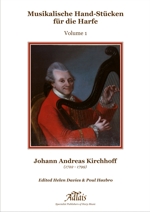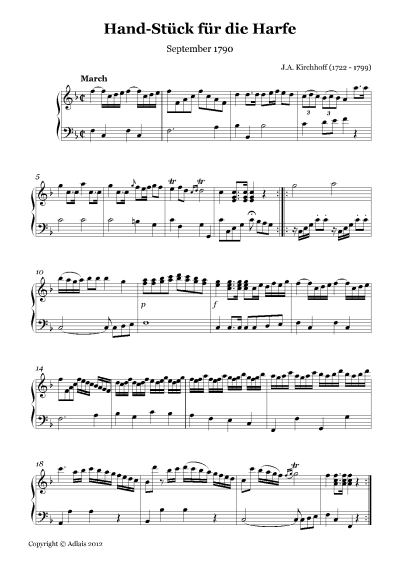 |
|||
| |
of Harp Music |
| © 2004-2025 ADLAIS |
| Musikalische
Hand-Stücken für die Harfe Volume 1 Johann Andreas Kirchhoff (1722 - 1799) Edited Helen Davies & Poul Høxbro |
return to previous page |
 |
Work: | Four Hand-Stück
für die Harfe (lessons for harp) 1. September 1790 2. October 1790 3. November 1790 4. December 1790 |
| Catalogue No: | Adlais 202 | |
| ISMN: | 979-0-57032-245-9 | |
| Edition: | 2nd Edition Revised June 2017 A4 stapled | |
| Suitable for: | Grade 5/6 Lever or Pedal Harp | |
| Price:: | £12.00 Go to shop | |
| Examination: | September 1790 is an LCM approved “own choice” piece for LCM Grade 6 List B Non Pedal Harp (2014-2016) providing notification is given at time of examination entry. Played in full omitting repeats. |
JOHANN ANDREAS KIRCHHOFF
(1722 -1799)
Harpist and composer Johann Andreas Kirchhoff was one of a number of German virtuosi employed at the Royal Opera House in Copenhagen in the 18th century. Contemporary written sources indicate that he was one of the greatest exponents of the harp of the time and that he was held in very high esteem, both in Denmark and internationally.
Kirchhoff was born in Wiessenfels, Saxony, on 27th March 1722. Little is known about his early life and education, but he spent some time in employment as court musician to the Duke of Weimar.
He also established himself as a soloist on the European music scene and it was on one of his foreign tours that he arrived in Denmark in 1758. He was on his way from St. Petersburg to England by sea, but when his ship was becalmed in the Sound between Sweden and Denmark, he went ashore. Hearing of the dangers of a sea voyage over the Kattegat at that time of year, he decided to spend the winter in Copenhagen. His fame had gone before him and he was presented to the reigning king, Frederik V, who was captivated by Kirchhoff’s harp playing and offered him a position at court, ensuring him that he would be held in the highest esteem. Kirchhoff was much taken by the King’s kindly disposition, and decided to settle in Denmark. In 1760 he was honoured with the title of “Royal Musician” and he played at the Royal court until his death.
Kirchhoff was a member of the Royal Opera Orchestra from 1772 – 1786 and in 1779 he was given Danish citizenship.
Theatre critics of the time singled out Kirchhoff for the brilliance of his playing in the orchestra – “…Herr Kirchhoff, whose harp playing is indispensable to this opera, and who delights his audience…” … “the only reason to see this piece is for the joy of Herr Kirchhoff´s playing…”. He was obviously a wonderful musician, and a great audience favourite.
He continued to tour abroad and was especially appreciated in Sweden and France. He received various other offers of employment and one especially lucrative offer of 2,000 rigsdaler a year came from France, but he refused saying that “King Frederik V has won my heart and I cannot be ungrateful.”
Despite ill health in old age, Kirchhoff continued to play and write for his beloved instrument. Writing of him in 1825, A.T. Elmqvist says:
“He frequently said that although he had visited many countries and many royal courts, he had never found such a good country as Denmark. Here one could live in complete security and no honest person had anything to fear.”
Kirchhoff died on 24th February 1799.
He was known as a composer as well as a virtuoso, but it had long been assumed that most of the music he wrote for the harp had been lost – and he himself is consequently almost forgotten. Research in Danish academic libraries, particularly in the Johan von Bülow Collection held at Sorø in the Bibliotheca Academiae Soranae has led to the discovery of many “Hand-Stücken für die Harfe”. Every one of them is in the form of a small suite and the collection is a treasure of charming, original harp repertoire.
The little iconographic evidence we have, coupled with the character of the music he wrote, would indicate that Kirchhoff played a hook harp. This harp had been developed in Germany and remained popular in northern Europe long after pedal harps had been invented. Hooks were fitted into the neck of the instrument to enable the player to manually raise the pitch of the string by a semi-tone by turning the hook with the left hand.
Since these “Hand-Stücken” were written for such an instrument, they are eminently suitable for the modern lever harp.
One definition of “Hand-Stück” is a “lesson”, and since Kirchoff wrote one of these a month from September 1789 – October 1793 (as well as more at a later date) it may well indicate that he was writing for pupils as well as his own performances.
Apart from adjusting a few very small rhythmic discrepancies we have chosen to remain faithful to the original manuscripts, hence the absence of phrasing, fingering and tempo markings.
Special thanks to Bibliotheca Academiae Soranae and librarian Ann Furholt Pedersen and to the The Danish Music Museum – Musikhistorisk Museum and The Carl Claudius Collection, Dr. Phil. Lisbet Torp (Head of Collections) and Marie Martens (research librarian).
Copyright ©2012 Helen Davies

